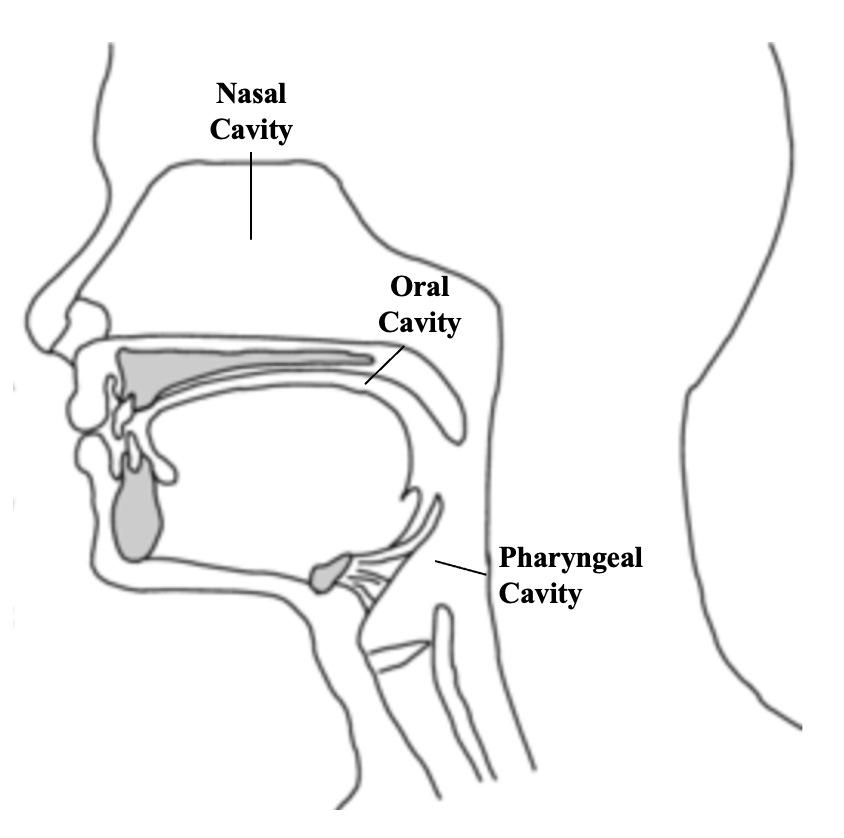Resonance of the Voice
The resonance and volume of a person’s voice impact intelligibility and can vary across language and culture. Since resonance can impact volume, or specifically the ability to increase volume, these two areas are addressed together.
Volume
Volume refers to the loudness or softness of your voice. It is the most obvious vocal element noticed of a speaker. Volume can also vary based on personality, culture, and languages spoken. For effective communication, a speaker should speak at a level so the listener can hear them, and that is comfortable for the listener’s ears.
Of course, the level of volume that is appropriate can vary across scenarios: the size of the audience, the size of the room, background noise, etc. Speakers should use a microphone for large audiences and rooms, so they do not have to strain their voice.
Resonance of the Voice
Resonance refers to the airflow as it passes through the pharyngeal (throat), oral (mouth), and nasal (nose) cavities. General American English resonates in the middle of the oral cavity. Other accents may use a more pharyngeal resonance or nasal
resonance. For example, French and Spanish are considered languages with a nasal resonance and sound nasal. Tagalog and Arabic are considered languages with a pharyngeal resonance and sound throaty or chesty. Resonance can also be impacted
by the size and shape of the oral cavity and vocal tract of individuals.

Professional speech resonates from the pharyngeal and oral cavities. Think of these two types of resonance as working together to help you maintain optimal pitch and a more powerful voice. Volume and resonance are closely related because it’s
easier to project your voice using an oral and pharyngeal resonance, than nasal.
Practice
Sit up tall and take 3 deep breaths. If needed, use a prop, such as hands or a clipboard, against the stomach. While taking deep breaths, the belly and prop should visibly move back and forth. After the deep breaths, focus on feeling the vibration in the lips. Take one breath per utterance. While producing oral resonance, you will feel a vibration in the oral cavity, not the nose. Practice holding this resonance by saying the following.
- A sustained ‘mmm’
- A sustained ‘mmm’ + vowel (e.g., ma, my, me, moo)
- Numbers 1-10
- Days of the week
- Months of the year
- /m/ words (e.g., maybe, money, more, my, mine)
- /m/ words in phrases (e.g., make more money)
If you are struggling with resonance, try these variations.
- Straw Phonation: Stick straw into a glass without water. While blowing into the straw, produce a sound, starting monotone and then changing pitch. Repeat and move from sounds to words and phrases (Above stimuli #2-6). Add water to the glass for more challenge.
- Resonance Hand: Place 4 fingers from one hand over their mouth vertically and produce a sustained ‘mmm,’ then slowly pull the hand away from the mouth. Repeat this with words and phrases (Above stimuli #2-6) and fewer fingers each trial.
Vocal Warmups
If you are like me, speaking for extended periods of time can leave you with a raspy voice. To avoid this, do vocal warmups before you speak. Taking what we discussed above, start with ‘m’ + a vowel (i.e., me, my mo, moo). Repeat that a few times. Then, change up the pitch while saying the syllables, moving the intonation up and down.

If you still notice fatigue or raspiness after you speak, do a few sustained ‘mmmm.’ This will reset everything.
What vocal warmups do you do? Let us know in the comments below ⬇️

2 Comments